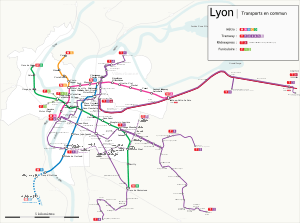Lyon tramway
 | |||
|
| |||
| Overview | |||
|---|---|---|---|
| Native name | Tramway de Lyon | ||
| Locale | Lyon, Rhône-Alpes, France | ||
| Transit type | Light rail/tram | ||
| Number of lines | 6 (T1-T5 & Rhônexpress)[1][2] | ||
| Number of stations |
107 (T1-T5)[1] 4 (Rhônexpress)[2] | ||
| Annual ridership | 91.000.000 (2016) | ||
| Operation | |||
| Began operation | 2001[1] | ||
| Operator(s) |
TCL (T1-T5) Rhônexpress (Rhônexpress) | ||
| Technical | |||
| System length |
66.3 km (41.2 mi) (T1-T5)[1] 22 km (14 mi) (Rhônexpress)[2] | ||
| Track gauge | 1,435 mm (4 ft 8 1⁄2 in) standard gauge | ||
| |||
| Public transport in Lyon |
|---|
| Networks |
|
| Railway stations |
| Airports |
The Lyon tramway (French: Tramway de Lyon) comprises six lines, five lines operated by TCL and one by Rhônexpress in the city of Lyon in Rhône-Alpes, France. The original tramway network in Lyon was developed in 1879, and the modern network was built in 2001.[1]
Line T1 opened in 2001; T2 opened in 2001; T3 opened at the end of 2006; line T4 opened in 2009; line Rhônexpress (airport connector) opened in 2010; and line T5 opened in 2012. The tramway system complements the Lyon Metro and forms an integral part of the public transportation system (TCL) in Lyon. The network of 5 tram lines (T1-T5) operated by TCL runs 66.3 kilometres (41.2 mi);[1] the single line operated by Rhônexpress runs for 22 kilometres (14 mi)[2] (including approximately 15 kilometres (9.3 mi) shared with the T3 tram line[2]). The network is currently served by 73 Alstom Citadis 302 and 19 Alstom Citadis 402 trams.
Line T1 extends from Debourg to IUT Feyssine via Perrache, Part-Dieu Vivier-Merle and Charpennes. Line T2 runs from Perrache to Saint-Priest – Bel-Air via Jean-Macé, Grange-Blanche and Porte des Alpes. Line T3 goes from Part-Dieu - Villette to Meyzieu Z.I. via Vaulx – La Soie. T4 Line connects La Doua at the Clinic Feyzin via Charpennes, Part Dieu Villette, Jet d'Eau and Gare de Vénissieux.
History: the original network (1879 - 1957)
The first steam-driven tram line, the number 12, linked Lyon and Vénissieux in 1888. The network was electrified between 1893 and 1899. Extensions to the suburbs were built until 1914. This was the height of the network - high quality service, low price, high frequency and high profitability for shareholders. The inflation after World War II made the network unprofitable. Beginning in the 1930s, tramways were progressively replaced with trolleybuses and later buses. A modernization plan, including underground sections in the city centre, planned in the 1940s was rapidly abandoned. The last urban tram ran on line 4 in January 1956 and the last suburban tram, the "Train bleu" in Neuville-sur-Saône, was abandoned in June 1957.
Original OTL network
The first tram network was built and operated by the Compagnie des Omnibus et tramways de Lyon (OTL), founded in 1879. It consisted of ten 1,435 mm (4 ft 8 1⁄2 in) (standard gauge), horse-drawn lines with a total length of 44 km serving Lyon, Villeurbanne, La Mulatière et Oullins .
In 1894, new electric trams were in service with these lines:
- 1 : Bellecour – Monplaisir via le Pont et la Grande Rue de la Guillotière
- 2 : Bellecour – Montchat
- 3 : Cordeliers – Villeurbanne
- 4 : Parc de la Tête d'or – La Mouche (now Jean Macé), extended to Perrache
- 5 : Bellecour – Pont d'Écully via Pont du Change
- 6 : Terreaux – Gare de Vaise via Quai Saint-Vincent
- 7 : Perrache – Les Brotteaux via Pont Morand
- 8 : Pont Morand – Saint-Clair
- 9 : Bellecour – Saint-Paul via Pont Tilsitt (now Pont Bonaparte)
- 10 : Bellecour – Oullins.
The first line to open was line 5, from Place Bellecour to Vaise along the Saône river, competing with riverboats. Lines 1 and 7 followed the approximate routes of the current metro lines D and A, respectively. The network was gradually extended, by the OTL and by acquisitions of competing operators, between 1894 and 1914.
OTL extensions
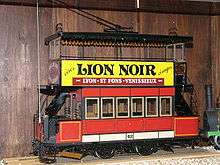
- 11 : Bellecour - Bon-Coin (Villeurbanne)
- 12 : Bellecour - Saint-Fons, extended to Vénissieux
- 13 : Cours Bayard (south of Perrache) - Place Commandant Arnaud (at the Croix-Rousse)
- 14 : Pont d'Oullins - Chaponost
- 15 : Charité - Pierre-Bénite
- 16 : Bellecour - Meyzieu - La Balme (Isère)
- 17 : Tolozan - Montluel (Ain)
- 18 : Gare Saint-Paul - La Mouche, extended to Gerland
- 28 : Cordeliers - Brotteaux
- 31 : Pont-Mouton - Saint-Rambert-l'Île-Barbe
- 32 : Charité - Vitriolerie.
La Société du Tramway d'Écully
1,000 mm (3 ft 3 3⁄8 in) (Metre gauge) lines to the northwest, acquired by the OTL in 1894.
- 19 : Pont-Mouton - Écully
- 20 : Pont-Mouton - Saint-Cyr-au-Mont-d'Or
- 21 : Pont-Mouton - Champagne-au-Mont-d'Or, extended to Limonest.
- 22 : Pont-Mouton - Saint-Didier-au-Mont-d'Or.
La Compagnie Lyonnaise des Tramways (CLT)
Metre gauge, steam powered lines on the left bank of the Rhône river. Became the Nouvelle Compagnie Lyonnaise des Tramways (NLT) in 1902, then acquired by the OTL in 1906.
- 23 : Pont Lafayette - Cimetière de la Guillotière, extended to Monplaisir-la-Plaine. The extension of the line, electrified to Saint-Priest used the number 34 from 1925 à 1935.
- 24 : Pont Lafayette - Asile de Bron, extended to Bron (Village).
- 25 : Cordeliers - Montchat, extended to Genas.
- 26 : Rue Casimier-Périer - Parc de la Tête d'Or
- 27 : Cordeliers - Vaulx-en-Velin.
La Compagnie du Fourvière Ouest Lyonnais (FOL)
Fourvière and Saint-Just funiculars and trams in the west plateau. Acquired by the OTL in 1910.
- 29 : Saint-Just - Sainte-Foy-lès-Lyon
- 30 : Saint-Just - Francheville.
La Compagnie du Tramway de Caluire (CTC)
Acquired by the OTL in 1914. Originally metric gauge, converted to standard gauge in 1925.
- 33 : Croix-Rousse - Caluire, extended to Les Marronniers (Fontaines-sur-Saône).
Tramway de l'Ouest du Dauphiné
This company reach Lyon in 1909.The meter gauge line leading to the east suburb was used on 6 km after being electrified in 1925.
- 34 Cordeliers - Saint-Priest
The current network (since 2001)
Following a decline in the 1950s and 1960s, public transit in Lyon was revived in the 1970s with the opening of the Lyon Metro. In 1996 a decision was made to build a new tram network to complement the metro. The first two lines were opened on 2 January 2001: Line T1 from Perrache to IUT-Feyssine via Part-Dieu and Charpennes and Line T2 from Perrache to Porte des Alpes via Jean-Macé and Grange-Blanche. Line T2 was extended to Saint-Priest on 27 October 2003 and Line T1 was extended to Montrochet on 15 September 2005, then again to Debourg on 19 February 2014. Line T3 (codenamed LEA) was opened on December 4, 2006 along the former Chemin de Fer de l'Est Lyonnais tracks from Part-Dieu Villette to Meyzieu. Line T4 opened on 20 April 2009, running from Jet d'eau - Mendès France to Hôpital Feyzin - Vénissieux, and was extended to La Doua on 29 August 2013. Line T5 opened on 17 November 2012, running from Grange-Blanche to Eurexpo.
Line T1
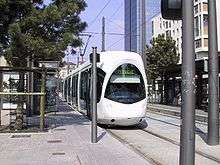
Operates from 04:40 to 00:35, maintained by the Centre de Maintenance de Saint-Priest - Porte des Alpes.
- Debourg (transfer metro B)
- ENS Lyon
- Halle Tony Garnier
- Musée des Confluences
- Hôtel de Région - Montrochet
- Sainte-Blandine
- Suchet
- Perrache train station (transfers: SNCF, metro A, tram T2)
- Quai Claude Bernard
- Rue de l'Université
- Saint-André
- Guillotière (transfers : metro D)
- Liberté
- Saxe - Préfecture
- Palais de Justice - Mairie du 3ème (transfer : metro B at Place Guichard - Bourse du Travail)
- Part-Dieu - Servient
- Part-Dieu (transfers: SNCF, tram T3, tram T4, Rhônexpress)
- Thiers - Lafayette (transfer: tram T4)
- Collège Bellecombe (transfer: tram T4)
- Charpennes - Charles Hernu (transfers: metro A, metro B, tram T4)
- Le Tonkin (transfer: tram T4)
- Condorcet (transfer: tram T4)
- Université Lyon I (transfer: tram T4)
- La Doua - Gaston Berger (transfer: tram T4)
- INSA - Einstein (transfer: tram T4 from 7.30am to 9am only)
- Croix-Luizet (transfer: tram T4 from 7.30am to 9am only)
- IUT - Feyssine (transfer: tram T4 from 7.30am to 9am only)
Line T2
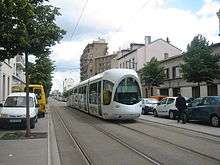
Operates from 04:55 to 00:34, maintained by the Centre de Maintenance de Saint-Priest - Porte des Alpes.
- Perrache train station (transfers: SNCF, metro A, tram T1)
- Centre Berthelot
- Jean Macé (transfers : metro B)
- Garibaldi - Berthelot
- Route de Vienne
- Jet d'Eau - Mendès France (transfer: tram T4)
- Villon
- Bachut - Mairie du 8ème
- Jean XXIII - Maryse Bastié
- Grange-Blanche (transfers: metro D, tram T5)
- Ambroise Paré (transfer: tram T5)
- Vinatier (transfer: tram T5)
- Essarts - Iris (transfer: tram T5)
- Boutasse - Camille Rousset (transfer: tram T5)
- Hôtel de Ville - Bron (transfer: tram T5)
- Les Alizés (transfer: tram T5)
- Rebufer
- Parilly - Université
- Europe - Université
- Porte des Alpes
- Parc Technologique
- Hauts de Feuilly
- Salvador Allende
- Alfred de Vigny
- Saint-Priest - Hôtel de Ville
- Esplanade des arts
- Jules Ferry
- Cordière
- Saint-Priest - Bel Air
Line T3
Operates from 04:32 to 00:06, maintained by the Centre de Maintenance de Meyzieu.
Codenamed "LEA" (Ligne de L'Est de l'Agglomération), Line T3 runs along a portion of the former CFEL (Compagnie des chemins de fer de l'Est de Lyon) train line which extended from the Gare de l'Est de Lyon to Saint-Genix-d'Aoste (via Crémieu, Jallieu et Montalieu).[3]
- Gare Part-Dieu Villette (transfers : Rhônexpress, SNCF, Metro B, Tram T1, Tram T4)
- Dauphiné - Lacassagne
- Reconnaissance - Balzac
- Gare de Villeurbanne
- Bel Air - Les Brosses
- Vaulx-en-Velin - La Soie (transfers: Metro A, Rhônexpress)
- Décines - Centre
- Décines-Charpieu - Grand Large
- Meyzieu - Gare
- Meyzieu - ZI (transfer: Rhônexpress)
- Meyzieu Les Panettes (only from Monday to Friday)
Line T3, which is 14.6 km long, runs largely on ballasted railroad track. It takes 23 minutes to go from Part-Dieu Villette to Meyzieu - ZI, and runs at a maximum speed of 70 km/h (60 km/h at intersections, of which 26 are equipped with crossing gates). 7 km run near residential areas and are equipped with a noise barrier.
Line T4
Operates from 04:39 to 00:45, maintained by the Centre de Maintenance de Saint-Priest - Porte des Alpes.
- IUT - Feyssine (7.30am to 9am only, as of November 2013)
- Croix-Luizet (7.30am to 9am only, as of November 2013)
- INSA - Einstein (7.30am to 9am only, as of November 2013)
- La Doua - Gaston Berger (transfer: tram T1)
- Université Lyon I (transfer: tram T1)
- Condorcet (transfer: tram T1)
- Le Tonkin (transfer: tram T1)
- Charpennes - Charles Hernu (transfers: metro A, metro B, tram T1)
- Collège Bellecombe (transfer: tram T1)
- Thiers - Lafayette (transfer: tram T1)
- Gare Part-Dieu Villette (transfers from platform nearby: tram T3, Rhônexpress - walking distance: SNCF, tram T1, metro B)
- Félix Faure
- Manufacture - Montluc
- Lycée Colbert
- Jet d'Eau - Mendès France (transfer: tram T2)
- Lycée Lumière
- États-Unis - Musée Tony Garnier
- Professeur Beauvisage - CISL
- États-Unis - Viviani
- Joliot Curie - Marcel Sembat
- La Borelle
- Gare de Vénissieux (transfers: TER, metro D)
- Croizat - Paul Bert
- Marcel Houël - Hôtel de Ville
- Lycée Jacques Brel
- Herriot - Cagne
- Vénissy
- Division Leclerc
- Maurice Thorez
- Lénine - Corsière
- Darnaise
- Hôpital Feyzin - Vénissieux
Line T5
Operates from 05:00 to 00:00 between Grange-Blanche and Parc du Chêne. Continues from Parc du Chêne to Eurexpo Convention Centre (8am-10pm) on every exhibition day.
- Grange-Blanche (transfers: metro D, tram T2)
- Ambroise Paré (transfer: tram T2)
- Vinatier (transfer: tram T2)
- Essarts - Iris (transfer: tram T2)
- Boutasse - Camille Rousset (transfer: tram T2)
- Hôtel de Ville - Bron (transfer: tram T2)
- Les Alizés (transfer: tram T2)
- De Tassigny - Curial
- Lycée Jean-Paul Sartre
- Parc du Chêne (service ends here when no Eurexpo conference)
- Eurexpo (only on conference days)
A projected extension to Chassieu, which would have added two new stations, Eurexpo 2 and René Cassin, was not approved by the public enquiry and has been postponed (possibly indefinitely) due to lack of support from local councillors.[4]
Rhônexpress
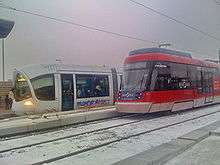
Rhônexpress is an express line which links Part-Dieu Villette to Saint-Exupéry airport, with intermediate stops at Vaulx-en-Velin – La Soie (transfer to Metro Line A) and Meyzieu ZI. It only serves four stations (including airport). The route is served by 6 tram trains, constructed by Swiss builder Stadler Rail. Its route consists of the existing T3 tram line, which is built with passing tracks to allow express service, and an 8.5 kilometres (5.3 mi) new track extension from Meyzieu ZI to the airport. Total length of track is 22 kilometres (14 mi)[2] needing approximately 30 minutes to go from Part-Dieu to the airport.[2] Service runs from morning until last flight arrival, with departures every 15 minutes at peak times.
Work began on October 9, 2008 and was completed August 9, 2010.[5] The Conseil général of the Rhône department franchised the operation rights for 30 years to Rhônexpress, a consortium including Vinci SA (28.2%), Veolia Transport (28.2%), Vossloh Infrastructure Service (4.2%), Cegelec Centre Est (2,8%) and the Caisse des dépôts et consignations.[6] Unlike the Lyon tramways, the Rhônexpress is not run by TCL. Stadler's Tangos are used as rolling stock.
Future
Work is under way on line T6, due to be opened in 2019, which will extend from the terminus of line T1 at Debourg to Lyon's eastern hospital complex. A subsequent extension of this line to La Doua, the university campus in Villeurbanne, is also envisaged.[7]
Rolling stock
The TCL fleet is composed of 73 articulated Alstom Citadis 302 trams built between 2000 and 2009. They have production numbers N°801 - 873. There are 19 articulated Alstom Citadis 402 which are only on the T3 line.
Six Stadler Tango trainsets are used for the Rhônexpress service.
See also
References
Inline citations
- 1 2 3 4 5 6 "Le Tramway sur le réseau TCL" [The Tramway in TCL's network] (in French). TCL - SYTRAL. Archived from the original on 2013-09-27. Retrieved 2013-09-25.
- 1 2 3 4 5 6 7 "La société Rhônexpress : les chiffres clefs du service offert" [The Rhônexpress company: Key figures for the service offered] (in French). Rhônexpress. Retrieved 2013-09-25.
- ↑ Le Chemin de fer de l'Est de Lyon de MM. Domengie, Alquati, Moulin et Roze, Les Éditions du Cabri, 1996
- ↑ "Le tram à Chassieu : comment perdre 10 ans". chassieunaturellementligne.blogspot.fr (in French).
- ↑ "Archived copy". Archived from the original on 2008-08-21. Retrieved 2009-03-09.
- ↑ Ville et transports - magazine, January 17, 2007
- ↑ "Création tramway T6". www.sytral.fr (in French). Sytral. Retrieved 1 February 2018.
Bibliography
- Lyon du tram au tram / Jean Arrivetz. - La Régordane, 2001. - ISBN 2-906984-37-X
- Sur les rails du Lyonnais : volume 2 : les réseaux secondaires, tacots, ficelles et métro / José Banaudo. - Les éditions du Cabri, Gérad Tisserand et De Borée 2002. - ISBN 2-84494-134-6
- 20 Minutes - Le tramway Léa fait ses premiers pas.
External links
| Wikimedia Commons has media related to Lyon tramway. |
- TCL official website (in English) (in French)
- Section of the SYTRAL site discussing lines T3 and T4 (in French)
- Lyon en Lignes (in French)
